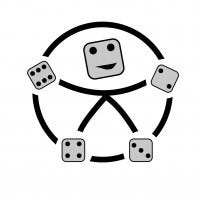Hunt the Syntax, References
These are the references for the Hunt the Syntax series of blog posts. They are of academic interest, in the most precise possible terms.

You can read more of my writing over at the Meeple Like Us blog, or the Textual Intercourse blog over at Epitaph Online. You can some information about my research interests over at my personal homepage, or on my profile at Robert Gordon University.
You can find part one of this series here and part two of this series here.
---
Aarseth, E. J. (1997). Cybertext: perspectives on ergodic literature. JHU Press.
Achterbosch, L., Pierce, R., & Simmons, G. (2008). Massively multiplayer online role-playing games: the past, present, and future. Computers in Entertainment (CIE), 5(4), 9.
Anderson, T., & Galley, S. (1985). The history of Zork. The New Zork Times,4(1-3).
Bartle, R. A. (2003). Designing Virtual Worlds. New Riders, 1st edition.
Bartle, R. A. (2010). From MUDs to MMORPGs: the history of virtual worlds. InInternational handbook of internet research (pp. 23-39). Springer Netherlands
Barton, M. (2008). Dungeons and desktops. The History of Computer Role-Playing Games. AK Peters: Wellesley (MA).
Brewer, N. (2014). Your Engineering Heritage: A History of Interactive Fiction and Adventure Games. [Available online from http://www.todaysengineer.org/2014/Mar/history.asp]
Brown, J. (1997). Gamers Claim AOL is Playing Bait-and-Switch. In Wired, June 24.
Dalenberg, R. (2004) . Adventure Family Tree. [Available online from http://www.mipmip.org/adv/advfamily.shtml]
Doran, J., & Parberry, I. (2010). Towards procedural quest generation: A structural analysis of RPG quests. Dept. Comput. Sci. Eng., Univ. North Texas, Tech. Rep. LARC-2010-02.
Douglass, J. (2007). Command lines: aesthetics and technique in interactive fiction and new media. ProQuest.
Drakkos, (2003). The Ten Commandments of Room Descriptions [Available from http://discworld.starturtle.net/lpc/about/articles/ten_commandments.html]
Drakkos, (2004). Unlisting the Listable. [Available online from http://discworld.atuin.net/lpc/about/articles/unlisting_the_listable.html]
Drakkos (2012). Cues and Clues. [Available online from http://epitaph.imaginary-realities.com/wp/?p=570]
Fernández-Vara, C. (2009). The Secret of Monkey Island: playing between cultures. Well Played 1.0: Video Games, Value and Meaning, 331.
Frenger, P. (1998). MUCKing around with Forth. ACM Sigplan Notices, 33(9), 20-24.
Heron, M.J (2012). Inaccessible Through Oversight: The Need for Inclusive Game Design. The Computer Games Journal 1(1). Glasgow, Scotland.
Heron, M. J. (2013). Likely to be eaten by a grue. Computer Games Journal,2(1), 55-67.
Heron, M. J. (2015). A case study into the accessibility of text-parser based interaction. In Proceedings of the 7th ACM SIGCHI Symposium on Engineering Interactive Computing Systems (pp. 74-83). ACM.
Karhulahti, V. M. (2013). Fiction Puzzle: Storiable Challenge in Pragmatist Videogame Aesthetics. Philosophy & Technology, 1-20.
Karlsen, F. (2008). Quests in context: a comparative analysis of discworld and world of warcraft. Game Studies, 8(1), 1-18.
Keegan, M. (1997). A classification of MUDs. Journal of Virtual Environment,2(2).
Koster, R. (2009). What is a Diku? [Available online from http://www.raphkoster.com/2009/01/09/what-is-a-diku/]
Lessard, J. (2013). Adventure Before Adventure Games A New Look at Crowther and Woods’s Seminal Program. Games and Culture, 8(3), 119-135.
Maher, J (2012a). ZIL and the Z Machine. [Available online from http://www.filfre.net/2012/01/zil-and-the-z-machine/]
Maher, J. (2012b). Level 9. [Available online from http://www.filfre.net/2012/10/level-9/]
Montfort, N. (2005). Twisty Little Passages: an approach to interactive fiction. MIT Press.
Montfort, N., & Short, E (2012). Interactive Fiction Communities.
Montfort, N. (2013). Riddle Machines: The History. A Companion to Digital Literary Studies, 267.
Morningstar, C., & Farmer, F. R. (2008). The lessons of Lucasfilm's habitat.Journal For Virtual Worlds Research, 1(1).
Raymond, E. S. (2001). The Cathedral & the Bazaar: Musings on linux and open source by an accidental revolutionary. O'Reilly Media.
Ryan, M. L. (2009). From narrative games to playable stories: Toward a poetics of interactive narrative. Storyworlds: A Journal of Narrative Studies, 1(1), 43-59.
Scott, J. (2010). Get Lamp: The Text Adventure Documentary [DVD]. New York, United States
Sorolla, R. S (2002). Crimes Against Mimesis. IF Theory Reader, 1.
Simpson, M. (2005). Interview with Steve Meretzky, co-author of the Game. [Available online from http://www.bbc.co.uk/radio4/hitchhikers/stevem.shtml]
Taylor, T. L. (2002, June). " Whose Game Is This Anyway?": Negotiating Corporate Ownership in a Virtual World. In CGDC Conf..
Tronstad, R. (2004). Interpretation, Performance, Play, & Seduction: Textual Adventures in Tubmud (Doctoral dissertation, Doctoral thesis. Oslo: Unipub).
Tronstad, R. (2005). Figuring the riddles of adventure games. Online Proceedings of Aesthetics of Play 2005.
Townsend, J, Heron, M.J. (2013). Authorship and Autership in the Collaborative Development Process of Text-Based Games. Chercher le Text: Locating the Text in Electronic Literature. Paris, France
Yob, G. (1975). Hunt the wumpus. Creative Computing, 1(5), 51-54.
Read more about:
BlogsAbout the Author(s)
You May Also Like













